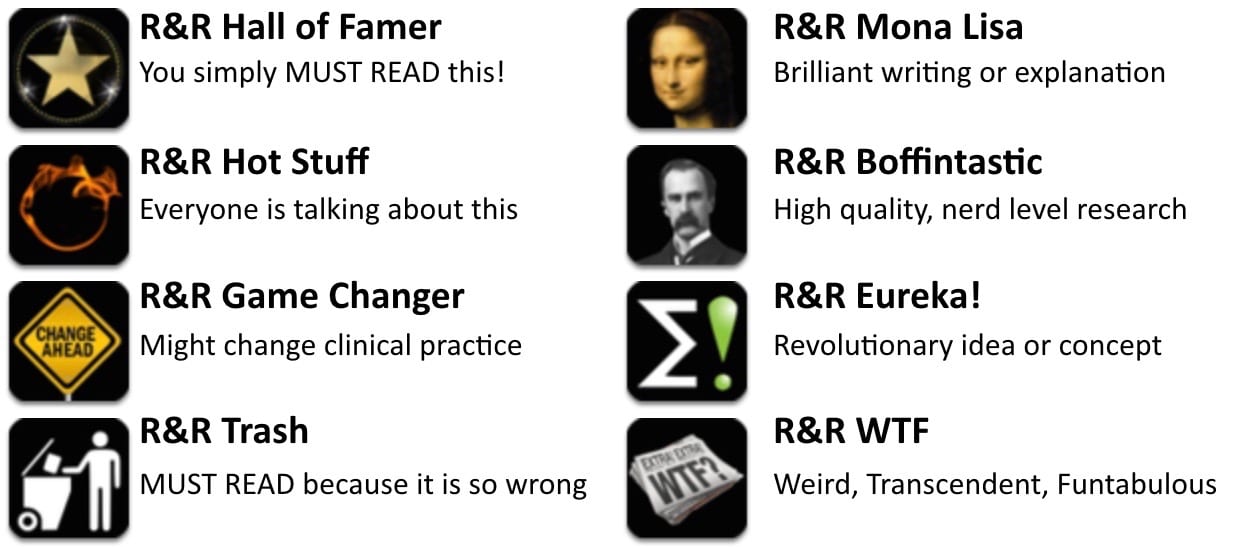R&R In The FASTLANE 090
Welcome to the 90th edition of Research and Reviews in the Fastlane. R&R in the Fastlane is a free resource that harnesses the power of social media to allow some of the best and brightest emergency medicine and critical care clinicians from all over the world tell us what they think is worth reading from the published literature.
This edition contains 8 recommended reads. The R&R Editorial Team includes Jeremy Fried, Nudrat Rashid, Soren Rudolph, Anand Swaminathan and, of course, Chris Nickson. Find more R&R in the Fastlane reviews in the : Overview; Archives and Contributors
This Edition’s R&R Hall of Famer
Frat JP et al. High-flow oxygen through nasal cannula in acute hypoxemic respiratory failure. NEJM 2015; 372(23):2185-96. PMID 25981908
Two different takes on a potential game changer in how we initially manage hypoxic respiratory failure from our contributors.
- “HFNC for acute hypoxemic respiratory failure improves mortality and patient comfort over BiPAP and standard oxygen therapy” — This is the headline you are going to see BUT is not the entire truth. Here are a few of the caveats….
- There were significant exclusion criteria so these patients only had hypoxic respiratory failure (single organ failure).
- Included a significant proportion of unilateral lung disease (not just ARDS patients) whose mortality is historically a lot lower.
- Significant (and unreported) cross-over rates between NIV and HFNC groups, and it’s unclear why tidal volume targets were 7-10 cc/kg ideal body weight.Bottom line: HFNC should not replace or delay definitive management (an ET tube) in patients with acute hypoxemic respiratory failure.
- We know in hypercarbic respiratory failure (i.e. COPD & CHF Exacerbations), NIPPV decreases mortality and intubation rate. In this study in patients with hypoxemic respiratory failure without hypercarbia (majority of population with pneumonia), HFNC appears to be superior to both NIPPV & O2 with Face Mask and should be strongly considered as first line treatment.
- Recommended by John Greenwood, Salim R. Rezaie
Zonfrillo MR et al. Emergency Department Visits and Head Computed Tomography Utilization for Concussion Patients From 2006 to 2011.Acad Emerg Med 2015. PMID: 26111921
- Increasing awareness exists on concussions/mild traumatic brain injury (TBIs) and this correlates with an increase in ED presentations for concussions between 2006-2011. Similarly, there’s been an emphasis on use of clinical decision aids for mild head trauma during this period. Despite this, a significantly limited database review found there was an 11.1% absolute increase in the rate of head CT for concussion patients over this period despite apparent decreased injury severity, measured by ISS. Concussion/mild TBI certainly deserves increasing awareness but inappropriate imaging doesn’t behoove anyone and appears to be a growing problem in this realm.
- Recommended by Lauren Westafer
Beam DM et al. Immediate Discharge and Home Treatment With Rivaroxaban of Low-risk Venous Thromboembolism Diagnosed in Two U.S. Emergency Departments: A One-year Preplanned Analysis. Acad Emerg Med 2015. PMID: 26113241
- Venous thromboembolism (PE and DVT) are almost always managed in the US with an inpatient stay while anticoagulation is begun. However, there are likely low risk groups that can be discharged from the ED without a hospital stay. This study prospectively looks at 106 patients with either DVT or PE who were identified as low risk based on the Hestia criteria. All of the patients were started on rivaroxaban (a Factor Xa inhibitor) and none had VTE recurrence (while on anticoagulation), major bleeding events or death due to VTE. This study further supports outpatient management for low risk VTE but a randomized controlled trial is needed (keep your eye out for the MERCURY-PE study)
- Recommended by Anand Swaminathan
- Further reading: SGEM #126: Take me to the Rivaroxaban — Outpatient treatment of VTE (The Skeptics Guide to EM)
Horowitz BZ, et al. Droperidol–behind the black box warning. Acad Emerg Med. 2002; 9(6):615-8. PMID: 12045077
- An older, but outstanding blow by blow look at the cases which led to the FDA black box warning on droperidol in the U.S. The authors examine each case submitted and find some curiosities:-55 of the 93 deaths reported were submitted on the same day
- The overwhelming majority of adverse event cases were reported with significantly higher doses of the drug than that routinely used in the EDThe authors also nicely summarize what we knew about alternative agents at the time of the editorial (2002), and is well worth reading for all those wondering why such a useful drug has been eliminated from the formulary at many hospitals. HT to Sean Nordt and Rob Orman for their discussion of the issue and editorial on ERCast.
- Recommended by Jeremy Fried
VERT Trial Collaboration group. Efficacy and safety of very early mobilisation within 24 h of stroke onset (AVERT): a randomised controlled trial. Lancet 2015. PMID: 25892679.
- In a massive and well-conducted RCT of 2104 patients with stroke, they randomized half of them to very early mobilization (median of 18.5 hours to first mobilization vs 22.4 hours), and more intensive mobilization (31 minutes per day vs. 10 minutes per day) for longer (202 total minutes vs 70 total minutes). Depending on how you prefer to analyze the results, there was either no difference (on the “assumption-free ordinal analysis” that uses the whole Rankin scale) or evidence of harm in the adjusted analysis that dichotomized the outcome scale.
- This surprised me–I had assumed that we were nowhere near giving “too much” exercise to anybody in any ICU. Apparently there may be a downward limb of the exercise/benefit curve. Clearly we need some more RCTs, not just willy-nilly assertions that more exercise is better. BUT, we should also remember just how much more exercise the usual care in this trial got, compared to the amount of exercise my typical medical ICU patients get. I do NOT think this paper provides an excuse to stop mobilizing patients who are currently getting next to nothing.
- Recommended by Jack Iwashyna
Kornhall DK et al. Intentional oesophagealintubation for managing regurgitation during endotracheal intubation. Anaesth Intensive Care 2015; 43(3): 412-4. PMID: 25943615
- Another case report demonstrating effective management of large gastric regurgitation during ETI by purposefully intubating the esophagus. An important technique to manage a difficult and dangerous scenario.
- Recommended by: Reuben Strayer
Hilton AK, Bellomo R. A critique of fluid bolus resuscitation in severe sepsis. Crit Care 2012; 16(1): 302. PMID: 22277834
- The concept of the fluid bolus in resuscitation of the critically ill, especially in septic shock, is almost sacrosanct. Hilton and Bellomo tear down the facade that underpins this dogma. Read this and you will be left wondering what to believe… Is it time for a FEAST trial in adults in the developed world? In the meantime, continue to take the middle road in septic shock – judicious use of resuscitation fluids (e.g. 2-3 L at most in most adult patients) and early use of noradrenaline.
- Recommended by Chris Nickson
Salminen P et al. Antibiotic Therapy vs Appendectomy for Treatment of Uncomplicated Acute Appendicitis The APPAC Randomized Clinical Trial. JAMA 2015; 313(23): 2340-2348. PMID: 26080338
- Can we treat acute, uncomplicated appendicitis with antibiotics alone? According to this RCT (can’t blind this one) the answer is yes. Antibiotics alone had a 72.7% success rate measured by the absence of needed appendectomy at 1 year. However, the failure rate (27.3%) exceeded their prespecified non-inferiority criteria of 24%. Appendectomy was successful in 99.6% of patients. Patients who underwent appy were much more likely to have complications (2.8% vs. 20.5%) but the vast majority of the appys were done by an open technique. Although we hoped this would answer the question, it has only added more. Antibiotics alone may be a reasonable 1st approach but we should expect a high failure rate if this strategy is pursued.
- An antibiotics-first strategy for acute appendicitis had a failure rate of about 27% at one year – not bad, but longer-term follow-up for durability of cure is needed to endorse such a strategy.
- Recommended by Anand Swaminathan, Ryan Radecki
- Further reading: The era of appendectomy is not over (Emergency Medicine Literature of Note)
Emergency physician with interest in education and knowledge translation. #FOAMed Fan | @jdfried |








@jdfried @EMSwami I’d have to disagree strongly with your interpretation of the last paper…Salminen P et al. Antibiotic Therapy vs Appendectomy for Treatment of Uncomplicated Acute Appendicitis The APPAC Randomized Clinical Trial. JAMA 2015; 313(23): 2340-2348. This has been a hot topic in the surgical literature for about the last 8-10 years and there have been multiple small, single and multi-centre studies done with severe methodological limitations on this topic. Finally, we have a large, multi-centre, non-inferiority (NI) trial to try and answer this question and the interpretation of the results is wrong. A non-inferiority trial attempts to show that a new or novel treatment/therapy is acceptably “non-inferior” to the current standard of care. By failing to do so, which this trial did, it in fact displays inferiority of the new therapy. Secondly, the pre-defined non-inferiority margin of 24% seems way too high and inconsistent with the prior studies done on this topic. In my opinion it suggests an attempt at statistical slight of hand.
A further limitation, this trial is unlikely applicable to the North American, Australian or majority of western European countries since most appendectomies in these countries are not performed open, but laparoscopically.
For a more complete and nuanced primer on NI trials, please see: Al Deeb M, Azad A, Barbic D. Critically appraising noninferiority randomized controlled trials: a primer for emergency physicians. CJEM. 2015 May;17(3):231-6. doi: 10.2310/8000.2014.141405.